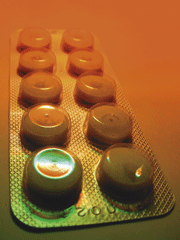RFID should help curb drug counterfeiting, but legislative and technical obstacles still exist
 By Marisa Torrieri, Contributing Editor, AVISIAN Publishing
By Marisa Torrieri, Contributing Editor, AVISIAN Publishing
Whether it’s the rising cost of prescription drugs or more sophisticated technology and funding for counterfeiters, incidents of drug counterfeiting have skyrocketed in the United States. Drug counterfeiting now costs the Food and Drug Administrations more than $30 billion annually, a number so great that the agency is embracing new technology that will help it give teeth to a law that requires the pharmaceutical industry to closely track a drug’s “pedigree.” That’s the term applied to a drug’s record documenting that it was manufactured and distributed under secure conditions.
Prior to RFID coming on the scene, pedigrees were kept as a paper trail – creating obvious problems with volume, accuracy and notation standardization. Today the FDA is looking to RFID as an alternative, creating an electronic or ‘e-pedigree.’ In response, the RFID industry is cooking powerful antidotes to thwart pharmaceutical crooks and grab a piece of this massive market opportunity.
A mandate for a drug pedigree has existed for nearly two decades since the Prescription Drug Marketing Act (PDMA) of 1987 called for all companies involved in the production and distribution of pharmaceuticals to keep rigorous pedigrees. But it was essentially unenforceable, says Joseph Pearson, pharmaceutical business development manager for Texas Instruments RFid Systems.
“There was no way to enforce the law because of the millions of products that go through the supply chain – from manufacturers to distributors to wholesalers to your local pharmacy,” Mr. Pearson says. “There was no way to do it until RFID came around.”
But just last year, FDA issued a report calling for all parties in a pharmaceutical supply chain to track and trace a product’s pedigree, and gave a big nod to RFID as the best way to accomplish that goal.
The FDA also said that it expects to start enforcing the PDMA by the end of this year, stating in the report that the “adoption of electronic track and trace technology would help stakeholders meet and surpass the goals of the Prescription Drug Marketing Act (PDMA). Until now, the FDA delayed its effective date for enforcing a number of the PDMA’s provisions … to allow stakeholders to move toward an electronic pedigree.”
In its report, originally issued in February 2004 but updated annually, the FDA praised RFID stating that “(it) is the most promising technology to meet this need … Implementation of RFID will allow supply chain stakeholders to track the chain of custody (or pedigree) of every package of medication. By tying each discrete product unit to a unique electronic serial number, a product can be tracked electronically through every step of the supply chain.”
Per the FDA’s recommendations, a number of states have followed by taking matters into their own hands. The best-known state law, “Florida’s Drug and Cosmetic Act,” requires components of the pharmaceutical supply chain to keep better records of a drug’s pedigree. The Florida law goes into effect July 1, 2006.
Inside the pharmaceutical supply chain
As with any supply chain operation reliant upon RFID as its backbone, pharmaceuticals have the opportunity to benefit from a system that enables monitoring throughout the entire supply chain.
What makes the transport of drugs a unique challenge is the security necessary to maintain privacy and prevent counterfeiting: because pharmaceuticals are highly coveted targets, it is necessary that an RFID system be able to meet federal pedigree requirements, as well as keep tabs on a product’s whereabouts at all points – from the factory to the warehouse to the pharmacy or health facility.
A June 2005 White Paper from Texas Instruments, “Securing the Pharmaceutical Supply Chain – The Authenticated RFID Platform,” described an RFID solution that included integrated PKI security. In short, the Authenticated RFID system validates transactions at multiple points, from the pharmaceutical manufacturing facility (where PKI-infused tags are signed) to multiple wholesale and distribution points (where a PKI tag is authorized). The product is authorized yet again its end point – the pharmacy.
It’s a seemingly smooth operation. But even Texas Instruments still faces a number of challenges to deployment.
Adding high-end security to existing RFID systems will increase the platform’s cost; there’s also the issue of who pays for this stuff, and how all involved parties will work together so that the network flows smoothly, Mr. Pearson says.
“We at TI recognize that the industry has a need for RFID technology today,” he says, noting that his team has develop Tag-it HF-I Standard and Professional products to suit the industry’s needs.
Tied in with cost are privacy concerns. Some worry rogues with readers might stand outside of pharmacies to get private information from a tagged container as it is carried away by the customer.
Although the likelihood of that happening seems low, Texas Instruments has acknowledged the pharmaceutical industry’s fears by adding a new feature to its product line.
The new Tag-it HF-I platform, offers password protected write functionality that allows decommissioning of certain information on the tag before it goes to the consumer. Should the need arise, sections of the tag containing product information can be decommissioned prior to the purchase or the RFID tag functionality can be completely disabled using a special command, Mr. Pearson says.
“The drug companies see a lot of advantages in RFID products,” Mr. Pearson says. “They can get more information, get better planning, and obviously they want to see a secure product in their distribution channels. There are advantages, from a pharmaceutical manufacturing perspective, but there has to be a network of connectivity for this to happen.”
Additional resources:
For a full draft of “Combating Counterfeit Drugs: A Report of the Food and Drug Administration Annual Update, click here.
For more information on Florida’s Drug and Cosmetic Act, click here.


